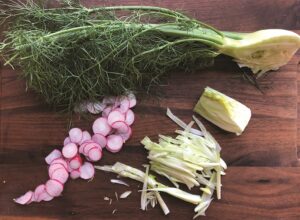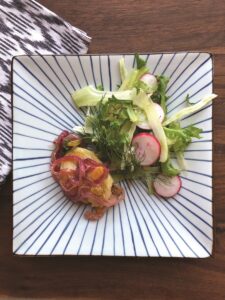These spring holidays are contradictory ones, foodwise and in every other way, it seems to me. I grew up eating Easter hams and hunting for eggs laid by chickens, presumably, but hidden, inexplicably, by a rabbit. The tale told at church was about a miracle, though it was pretty hard to forget the dark interlude that made the resurrection such a relief.
At the Passover table, it’s easy to love the spring greens but also to notice they are dipped into a bowlful of tears — and for good reasons. Here, too, the story of deliverance comes with ancient terrors, in this case of enslavement and plagues.
At our house, which combines both traditions in a secular direction, we linger over the seder and allow a lot of interruptions and sidebars to help us remember the Exodus story’s endless twists and turns. So, instead of waiting it all out before we eat, we serve small courses to carry us through and to mitigate the effects of the four glasses of wine — the cups of sanctification, remembrance, skepticism, and acceptance — that are essential to the telling.

A little bowl of fresh pea soup or a radish salad might come alongside the initial stage setting, usually a discussion of how the Passover seder is probably really a reenactment of an ancient spring barley festival.
When we recount the fact that forced labor was what built the pyramids we pass around matzo, horseradish, and charoset, and make little sandwiches recollecting bitter tears and sweet escape.
Next, we might listen to Bob Dylan singing “Highway 61 Revisited”: “God said to Abraham, ‘Kill me a son,’ ” to review how that all went down. Memories of Charlton Heston as Moses fill in the stretch of narrative about the parting of the Red Sea. Elie Wiesel is the best source on the importance of not gloating when your adversary is vanquished. This part is accompanied by a small fish course.
The youngest people at the table ask the traditional four questions, to which I would like to suggest adding a fifth: Why gefilte fish? They must have at some point in history been very nice quenelles. But floating as they do in those jars at the end of supermarket aisles, they are not inspiring.
That kind of question will send somebody rummaging around for David Bader’s Haikus for Jews and, giving up on finding it, trying to recite from memory: “No fins and no tail/ the gefilte fish swims with/ some difficulty.”

I have an answer. It is a make-ahead, serve-at-room-temperature fish course that works well for a drawn-out spring feast. And in keeping with the juxtapositions of the day, it’s an agrodolce — a Mediterranean sweet and sour, this one made with quick pickled red onions and raisins.
The recipe calls for appetizer-sized portions of firm-textured fish, and 20 years ago, the first time I made it, I did what Gourmet magazine told me to do and chose halibut. But it will be another month before halibut arrives here from the Gulf of Maine. And because it is overfished, the season is really short. A thick piece of cod loin could work, though it’s hard to make it hold together in perfect little rectangles. Monkfish medallions would be good. But a pile of cod cheeks — meat taken from the sides of the fish’s head — caught my eye at the fish market yesterday.
“They’re a treat some chefs hoard,” says Mac Hay. At this time of year, his stores don’t cut enough cod to have a big supply, but sometimes he brings them home from trading in Boston. Sweet and firm, they’re just the sea-scallop-size morsels to replace gefilte fish.
Cod Cheeks With Pickled Red Onions, Raisins, and Fennel Salad
Serves 6 as an appetizer
For the fish:
¼ cup golden raisins
½ cup sherry vinegar
1 Tbsp. sugar
1 red onion
¼ cup olive oil, divided
6 cod cheeks or 1 lb. firm fish fillet
2 Tbsp. potato starch
For the salad:
1 small fennel bulb
6 radishes
3 handfuls crisp spring greens
¼ cup olive oil
2 Tbsp. sherry vinegar
Pinch each salt and sugar
- Combine ½ cup vinegar with sugar and raisins in a small saucepan and simmer to plump the raisins and reduce the vinegar some, about 3 minutes; set aside to cool.
- Slice onion thin and sauté in a skillet slicked with 2 tablespoons of olive oil. Cook and stir gently until onions are soft without letting them brown, about 5 minutes; set aside to cool.
- Trim silverskin from the cod cheeks (or slice a thick fillet into 6 even pieces). Season the fish with salt and pepper and dredge in potato starch. Heat two more tablespoons of olive oil in a small skillet and pan-fry the fish until golden on one side, about 3 minutes. Flip carefully and fry for a minute or so more. Remove and set aside.
- Spread softened red onion on the bottom of a ceramic or glass dish and place fish on top. Add the rest of the onion, then spoon on the raisins and reduced vinegar. Refrigerate all day or overnight.
- Bring the fish to room temperature while you prepare a small salad of slivered fennel bulb, thin-sliced radishes, and lettuce. Whisk the oil, vinegar, sugar, and salt, and dress the salad lightly. Plate it alongside the fish. If you saved a few fennel fronds, they make a nice garnish.
